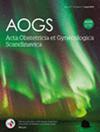Inpatient vaginal dinoprostone vs outpatient balloon catheters for cervical ripening in induction of labor: An individual participant data meta-analysis of randomized controlled trials
Abstract
Introduction
Outpatient cervical ripening and induction of labor might offer potential benefits. There are a few randomized controlled trials (RCTs) comparing outpatient balloon catheters with inpatient vaginal dinoprostone, but the reported outcomes among these trials were inconsistent, justifying the need for a meta-analysis. We aimed to evaluate the effectiveness and safety of inpatient vaginal dinoprostone compared to outpatient balloon catheters for cervical ripening in labor induction.
Material and Methods
Eligible RCTs were identified using MEDLINE, Emcare, Embase, Scopus, CINAHL Plus, Cochrane Pregnancy and Childbirth Group's Trials Register, WHO International Clinical Trials Registry Platform, and clinicaltrials.gov from inception to July 2024. Women with live singleton pregnancies at 34 or more weeks of gestation were eligible. The authors of eligible trials were invited to share their de-identified data. The main outcomes were vaginal birth and a composite adverse perinatal and maternal outcome. All analyses were adjusted for age and parity. Two-stage random effects meta-analysis was the main analysis strategy with the intention-to-treat principle. This meta-analysis was registered with PROSPERO (CRD42022313183) on 27-04-2022.
Results
We identified three eligible RCTs, and all three shared data (N = 1636); inpatient vaginal dinoprostone (n = 832), outpatient balloon catheter (n = 804). The odds of vaginal birth were higher after inpatient vaginal dinoprostone than outpatient balloon catheter (67.8% vs 61.7%, adjusted odds ratio [aOR] 1.30, 95% CI 1.05–1.62, I2 = 0%). There was no significant difference in the composite adverse perinatal outcome (13.7% vs 13.1%, aOR 1.09, 95% CI 0.75–1.58, I2 = 28.7%) or the composite adverse maternal outcome (16.6% vs 19.8%, aOR 0.81, 95% CI 0.61–1.07, I2 = 11.5%). The difference in effect on vaginal birth rate varied according to body mass index. Overweight and obese women had a lower vaginal birth rate after outpatient induction, whereas for those with underweight/normal weight, the rates of vaginal birth were similar.
Conclusions
Balloon catheter used in an outpatient labor induction setting probably leads to fewer vaginal births compared to vaginal dinoprostone in an inpatient setting. In pre-planned subgroup analysis, for pregnant women with underweight/normal weight, both inpatient vaginal dinoprostone and outpatient balloon catheter methods are viable options, but balloon catheter has a lower vaginal birth rate in women with overweight and obesity during pregnancy. The perinatal and maternal safety profiles are comparable.


 求助内容:
求助内容: 应助结果提醒方式:
应助结果提醒方式:


